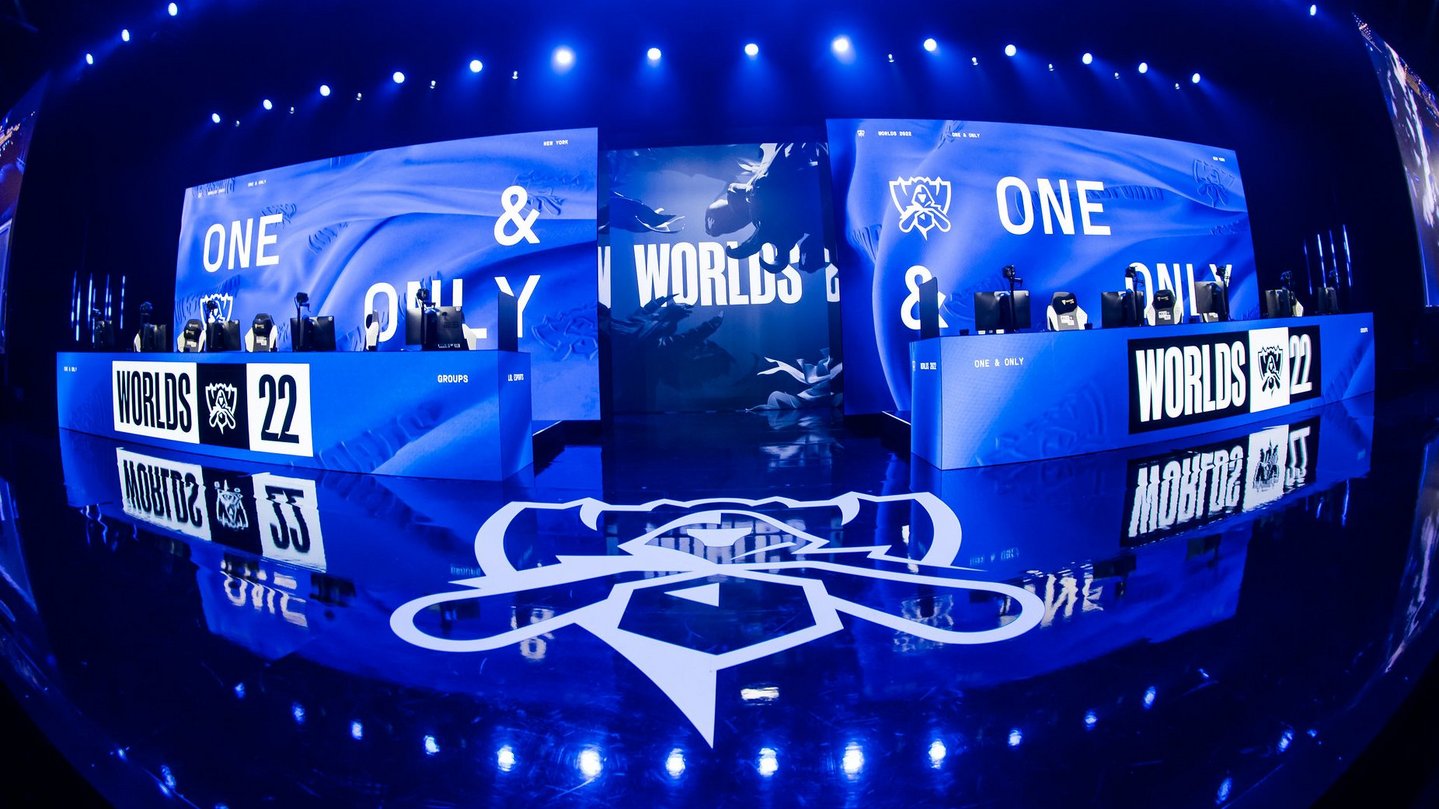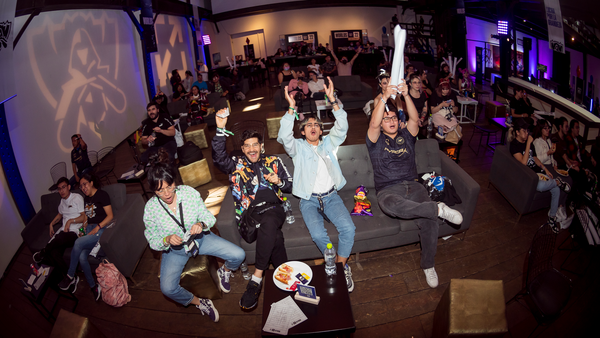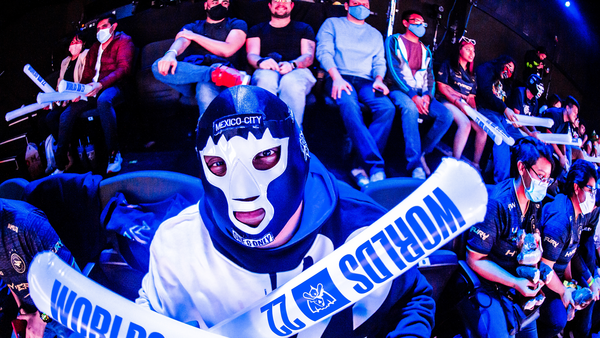With Worlds traveling from Mexico City to New York, to Atlanta, and finally to San Francisco, fans in North America have had a chance to attend in person for the first time since 2016. As tens of thousands of fans pack the sold-out State Farm Arena and Chase Center, millions more fans around the world watch the action unfold online.
“We work on a world feed model similar to something like The Olympics or The World Cup,” said Sam Chaimson, Manager of Live Broadcast Production at Worlds. “Whether you’re the English feed covering the event in-house, or you’re the French feed through a third-party partner in Paris, or you’re in China, Brazil, or Korea producing the show, we want to make sure every fan around the world has the best Worlds experience possible.”
In all, the global events team works with 22 broadcast partners who create shows in 21 different languages.
“We create this kit of all the things happening at the venue along with Worlds-branded graphics, music, and videos,” Sam continues. “That’s how we get to a point where 70 million people around the world are tuning in for the finals. No matter how big or small your production footprint is, you can give fans in your region, who speak your language, the Worlds experience they deserve.”
During Worlds 2021, viewership peaked at 73.8 million concurrent viewers during the finals between Korea’s DWG KIA and China’s Edward Gaming. The average minute audience, the metric Nielsen uses to calculate television ratings, was just over 30 million for the finals. Both numbers represented new records for Worlds and for esports events as a whole.
While that number represents the totals, there are slight differences in the broadcast for every region. As the language changes, so do the casters and the stories they tell. When Worlds reaches the finals, there are only two teams left to talk about. But during the early stages, when matchups consist of 24 teams from 11 different regional leagues, local broadcasts tailor their content to their audience.
“Our broadcast days start a few days before anything goes live,” says Eamon Frasher, Manager of Live Broadcast Production. “We have our story meeting where we go game-by-game and talk about the biggest stories of the tournament, the best matchups, the players we want to spotlight. So for the North American, European, and Oceanic feed, or NEO, we focus more on those regions and the stories that will resonate with most viewers who are watching in English.”
Still, that doesn’t mean the broadcast will prioritize the storylines for English-speaking regions above all else.
“For example, going into the tournament, we knew Diego ‘Brance’ Amaral for LOUD was a rising star,” Eamon continued. “And during play-ins and Champions Queue, we saw his personality come through so we spent more time on his story. Same with RNG, we knew their story of being MSI champs and having to fight through play-ins, but also knowing they were probably going to go pretty far, was going to resonate with audiences.”
As Worlds continued on, the stories emerge and shift. Every night, after the broadcast, the esports production team holds a debrief meeting to talk about everything that happened and some of the stories coming up the next day.
“We work on an around-the-world model for the English feed,” said John Depa, a Live Broadcast Producer. “The broadcast wraps after midnight in NYC, then we have a post-broadcast meeting where we are joined by some of the LEC staff. Then the team in Berlin, during their workday, scripts the show and begins creating graphics for the next day's broadcast. When we wake up in the morning, there’s already things in place for the day.”
For an event like worlds, there’s only so much planning that can be done, so the team has to blend pre-planned stories with what’s happening on the rift in real-time.
“Sometimes we have a game like GAM Esports upsetting TOP Esports and it’s like, ‘well, scrap that, we’re just going to talk about this game,’” Eamon said. “As the games are going on, producers are talking with the talent to make those calls. We have to balance how long we talk about the previous game with how long we spend previewing the next one.”
Around the world, different teams are making their own decisions on what they want to highlight during the broadcast. Viewers in China may see a preview of the upcoming match featuring an LPL team while viewers in North America will see the post-game interview with someone like Vulcan.
When Worlds is in Europe or North America, the primary broadcast is handled by a collaboration between Europe’s LEC and NA’s LCS. Viewers see that firsthand at the casters' desk and with post-game interviews, but it’s also happening behind the scenes as producers on LEC and LCS tag team these global broadcasts on-site at Worlds, in Los Angeles, and in Berlin.
The broadcast starts, naturally, in the arena with the players. From there, the feed goes directly to Los Angeles using Riot Direct, the same server infrastructure that we use for our games, where the world feed is then curated. At that point, it goes out to regional teams in Brazil, China, Korea, Turkey, and all of the other regions that have their own unique broadcast for Worlds, all featuring their native language and stories that resonate with those specific audiences.
“This handoff model between our world feed and the regional broadcasts, I think that’s what makes Worlds unique,” John said. “All of these feeds are following the exact same gameplay at the same moment so they're experiencing it together when the game is going on. Then after the game, the local commentators focus on the local stories and they make sure that as many people as possible get the best Worlds experience for what they care about.”
As Riot grows, so does the investment in esports infrastructure around the globe. New Stryker facilities such as the one in Dublin will help us continue to refine the handoff structure and utilize talent around the globe who are dedicated to telling the stories of League of Legends esports.
“As a producer, I make sure we are working towards one vision,” Sam says. “But at the end of the day, our show is carried out by masters of their fields that deliver the results. The graphics producers, replay producers, technical directors, sound engineers, they’re the ones who really create value for fans. It’s the observers finding the clutch in-game moments and the tournament operations who make the whole event happen. I’m there to guide everyone’s work to one goal but I’m privileged to work with experts in their craft who make the magic happen.”
If any of this sounds interesting and you’re interested in joining Riot’s esports team, we’re hiring! There are currently 40 open roles in esports with openings in Los Angeles, Seattle, Singapore, Berlin, Seoul, and Tokyo.


